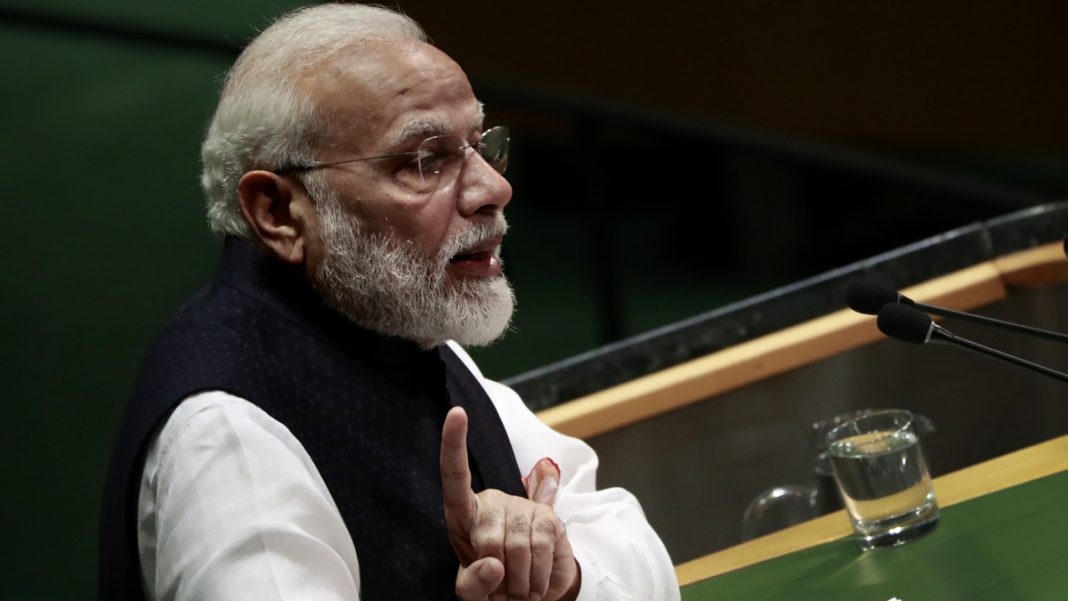Modi is not Manmohan Singh. He won’t fade away without fighting to the finish

In the 7 years since he took oath, Narendra Modi’s government has never looked as shaky as it does today. But there is still no alternative.
The nation-wide Black Flag protest call by the farmers’ movement on the occasion of the seventh anniversary of the Narendra Modi government today tells us something about the need for political alternatives. It also offers a hint as to how such an alternative might come about.
In the seven years since he took oath, Narendra Modi’s government has never looked as shaky as it does today. Its aura of power is melting. For Modi-sceptics, the botched-up handling of the second wave of the Covid pandemic – under-testing the patients and under-reporting the dead, lack of preparedness, unavailability of oxygen, and vaccination bungling — has confirmed its callousness bordering on cruelty. For many die-hard Modi-believers, the absence of the government during this crucial period has punctured the myth of omnipotence build around the Prime Minister. They have begun to entertain a suspicion that the PM is not quite in control of things, and not as powerful as he appears.
The carefully designed image of the all-powerful PM is coming unstuck in the political arena too. The anti-CAA protests showed that a small but determined group could stand up to this government. The farmers’ movement has already demonstrated that this government can be pushed on the back foot. West Bengal has called the bluff of the electoral prowess of the PM and his party. After seven years of untrammelled exercise of power, the Modi government has to contend with a truth that troubles all authoritarian rulers: power corrodes; absolute power corrodes absolutely.
Modi-bashing won’t lead to his defeat
Momentarily, the Modi government resembles the second innings of the Manmohan Singh government, whose countdown had begun in 2012. It might seem that the PM has lost his charm, that the government would collapse under the weight of the mountain of lies that it has spun to cover up its misgovernance and misdeeds. The opposition has to just wait and watch, and possibly unite.
Here lies the danger. The danger is in assuming that the Modi government’s countdown has begun, in believing that democracy’s self-correcting mechanisms will control the excesses of this government, that history will do the job for us.
Nothing can be farther from the truth. At this moment, we are liable to over-read popular anger with the Modi government and under-estimate its reserve of popular support. There is certainly widespread discontent, disappointment and disaffection with the Modi government today, but it need not result in its popular rejection. There is a fairly large section that might back the incumbent irrespective of its governance record. For the rest, disappointment may not turn into disgust that leads voters to throw out the incumbent at all cost. In any case, the sight of all opposition leaders holding hands together may not enthuse the voters; it might only reinforce the impression of one man against a gang.
Besides, the Modi government is bound to come up with a counter-offensive. At this moment, we are liable to underestimate the sheer power of propaganda at the command of the ruling establishment. Its spin-doctors are waiting for the storm to blow over before they launch the usual games of deflecting the blame, distracting the public and delaying the encounter with the public. They are waiting for an opportune moment to launch a vicious attack on the challengers. Its stories would be amplified with the help of money, media and organisational machinery. One thing is for sure: Unlike Dr Manmohan Singh, PM Modi will not fade away without fighting to the finish, without exhausting all the vast means at his command, fair and foul.
Let us be clear: Despite all his blunders, mere Modi-bashing won’t lead to his defeat; the people look for an alternative before they can discard what they have. And let us face it: Such an alternative does not exist, at least not on the menu that an ordinary person gets to see. This is not to discount the existing opposition parties, nor to dismiss the need for their unity. Opposition unity is necessary but not sufficient. The opposition needs a glue that holds it together and a glow to radiate hope among the people. As of now, it doesn’t seem to have either. This is why we need an alternative to supplement the existing opposition.
An alternative model for the future
Such an alternative to Modi would need, first of all, a positive and believable message about India’s future. Beyond a point, people do not want to hear what has gone wrong in the past; they want to know how things can get better in the future. This time it cannot be fake dreams and ‘jumlas’. Having fallen for it once, the people now need something solid, something believable. The message must be universal, simple and inspire confidence. That message does not exist in the public domain today. It cannot be conjured up from the ideologies of the 20th century. The language of the old ideologies of the bygone era does not work with today’s India. A fresh message must involve a coming together of fresh ideas, a fresh combination of policies and positions.
Once we have a positive and believable message, we need credible messengers. Their words must carry more weight than run-of-the-mill politicians’. The opposition is deficient in this respect too. We do not have a JP, or Jayaprakash Narayan, with us today. At the same time, Indian public life is not bereft of leaders with proven track record of selfless public service, integrity and intelligence. Some of them must step forward to respond to this historic need.
Finally, we need a powerful machine to carry this message across the country. This machine needs two parts: Organisation and communication. Today, there is nothing in the oppositional space that can match the BJP on both these counts. Many of the opposition parties have their cadre, no doubt. Therefore, bringing the existing opposition parties on board is necessary for building an alternative. But it is not sufficient. A new alternative must involve a large-scale mobilisation of citizens, mainly younger citizens, who have hitherto remained outside the political domain. Bringing this fresh energy into political life is a must to meet the current challenge. A powerful communication machine, with an IT team to match the BJP’s, must supplement the organisation on the ground. India needs a Truth Army to take on the troll army of the RSS-BJP.
The creation of such a positive and viable alternative is the most pressing political task for those who believe in the idea of India, those who respect our constitutional values, those who despair at the erosion of democracy, and those who are committed to reclaiming our Republic.
Would someone respond to this call of our times? If yes, how would this process unfold? We do not have answers. But today’s protest offers us a clue: farmers’ movement took the lead, followed by trade unions and other organisations, before the political parties extended their support. Is that a model for the future?




